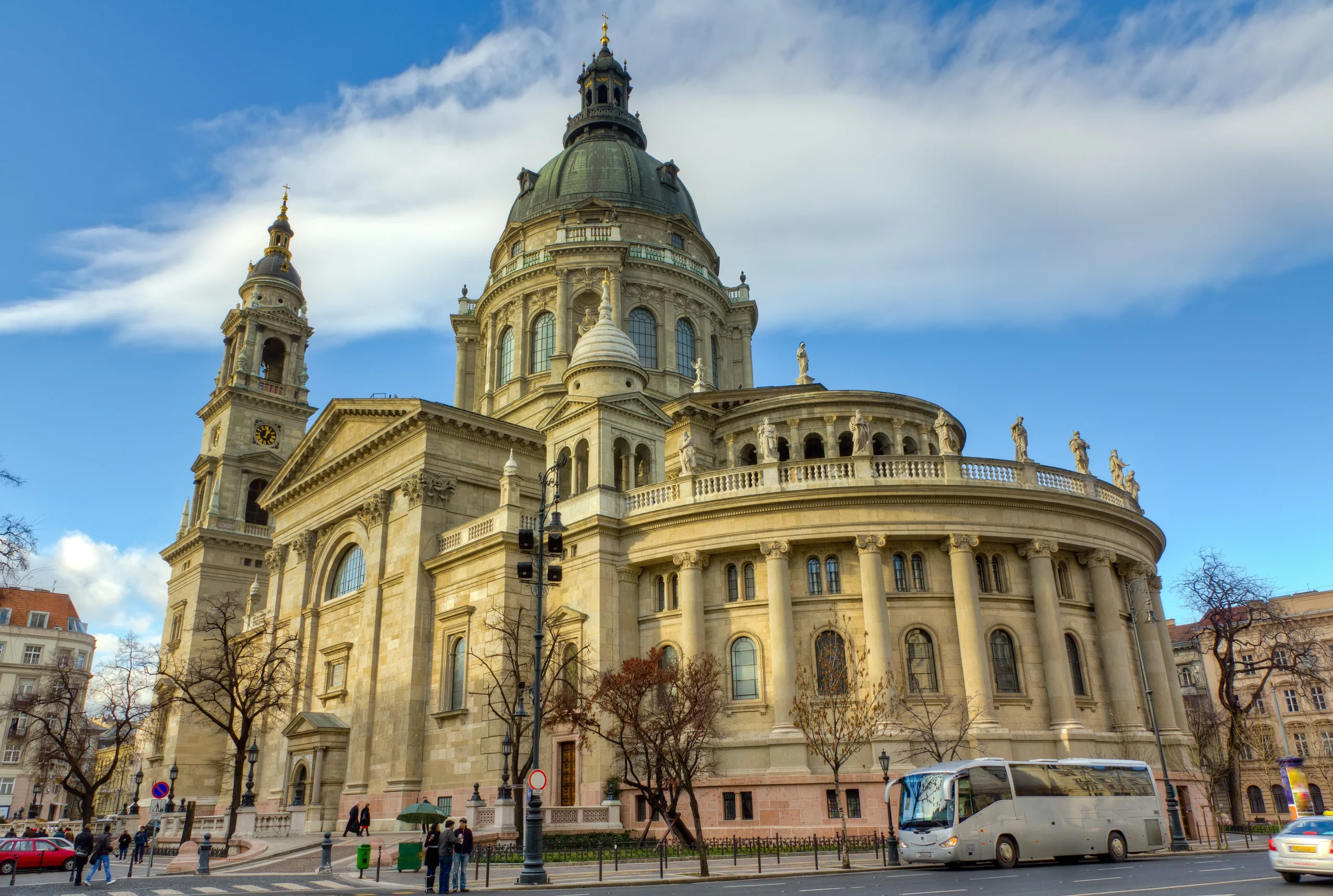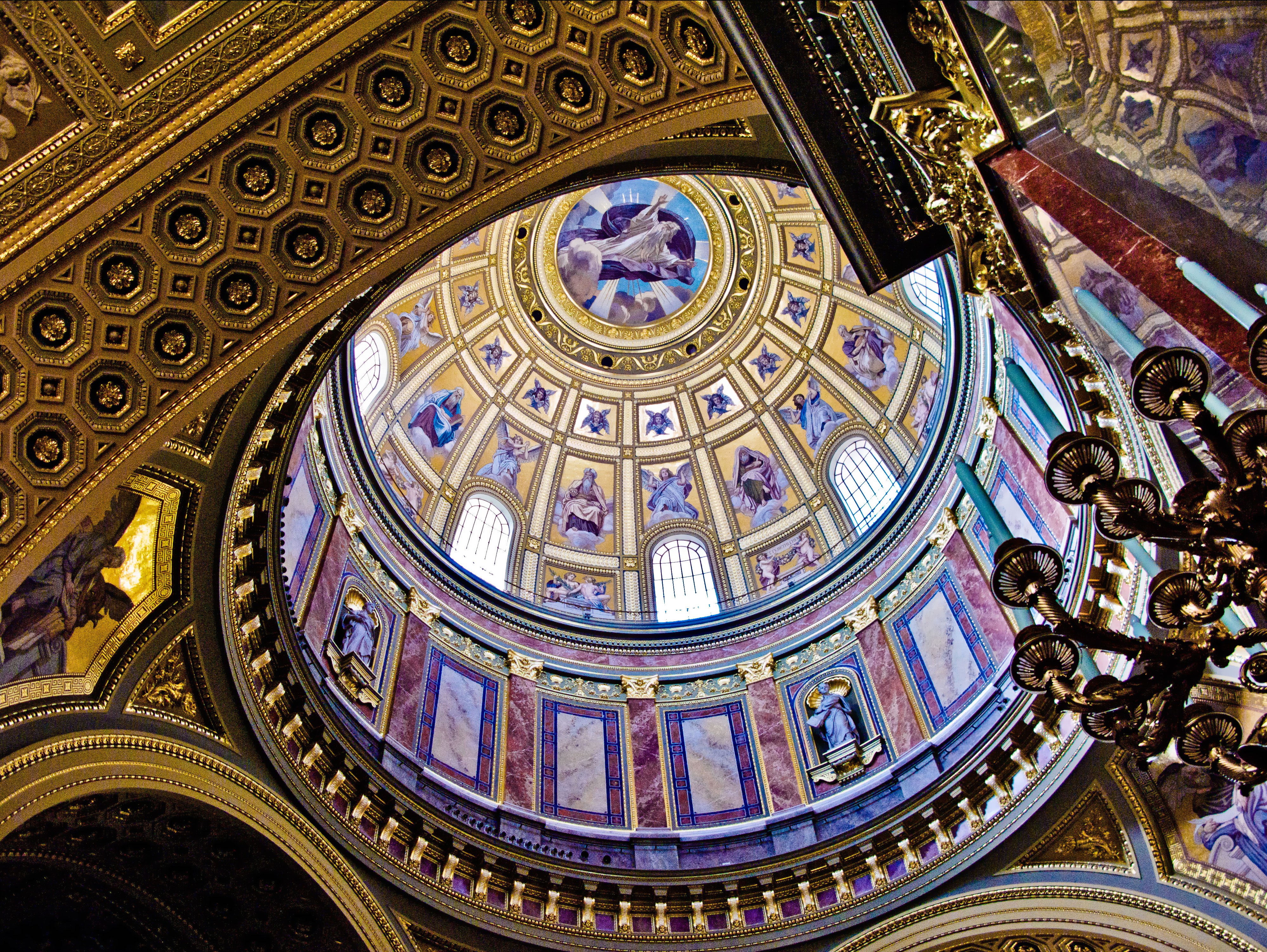Photo by: DepositPhoto.com – All rights reserved. Do not reuse without permission.
Exterior view of St. Stephen’s Basilica from street level, showing the neoclassical facade with its large central dome, twin bell towers, and columned entrance, surrounded by trees and urban streetscape.
Is St Stephen’s Church Budapest Worth Visiting? What You Need to Know
Towering over central Budapest, the lendery St. Stephen’s Church Budapest (Szent István Bazilika) is more than a religious site—it’s a national icon. With breathtaking architecture, a sacred royal relic, and soaring views from its panoramic dome, this basilica offers one of the most unforgettable experiences in the city. Whether you’re a history buff, art lover, or spiritual seeker, this must-see landmark blends awe and inspiration in equal measure..
This magnificent building in Budapest is not only a place of worship but also a treasure trove of Hungarian history and art. With its stunning architecture, rich history, and cultural significance, the basilica draws visitors from around the globe, eager to experience its grandeur and spiritual atmosphere.
Whether you’re interested in attending organ concerts, exploring its artistic details, or learning about St. Stephen, the first king of Hungary, the basilica offers something for everyone. It serves as a prominent symbol of Budapest and Hungarian national identity.
Introduction to St Stephen Basilica, Szent István-bazilika
The legendary Szent István Bazilika—known worldwide as St. Stephen’s Church Budapest—rises as a symbol of faith, resilience, and national pride. From its glorious dome to the awe-inspiring interior, every detail tells a story of Hungary’s royal past and spiritual heritage.
Dedicated to St. Stephen, the first king of Hungary (Szent István in Hungarian), this majestic building is a testament to Hungarian history and architectural prowess. The basilica is not only a place of worship but also a significant cultural attraction, hosting organ concerts and choral performances that draw music lovers from around the world.
Visitors can explore its magnificent interior, admire the stunning architecture, and learn about the life and legacy of St. Stephen. The basilica truly represents the spirit and history of Budapest and Hungary.
Historical Significance of St. Stephen
Construction of St. Stephen’s Church Budapest began in 1851, a period marked by the Austro-Hungarian Empire’s ambition to create monumental landmarks that reflected national identity and spiritual unity. This monumental project spanned over five decades, evolving through various political and architectural phases.
The construction of the basilica itself is a story of perseverance, marked by challenges such as the collapse of the dome in 1868, which necessitated significant rebuilding efforts.
According to tradition, the basilica now stands near the very spot where Hungary’s first king offered his final prayers, adding a layer of sacred mystery to the visit.. The church serves as a reminder of Hungary’s Christian heritage and the enduring influence of St. Stephen on Hungarian identity.
After years of perseverance—including rebuilding after the dome collapse—the basilica was finally consecrated in 1905, marking its official role as a spiritual and national symbol.
The consecration ceremony was a deeply symbolic event, attended by church officials and dignitaries, affirming the basilica’s place as a spiritual beacon for Hungary’s Catholic community.
Overview of the Szent István-bazilika Architecture
The architecture of St. Stephen’s Basilica showcases a blend of neo-classical styles, reflecting the vision of several architects, including Miklós Ybl, a prominent figure known for his work on the Hungarian Opera House. The basilica’s design is based on a Greek cross plan, with its imposing dome dominating the Budapest skyline.
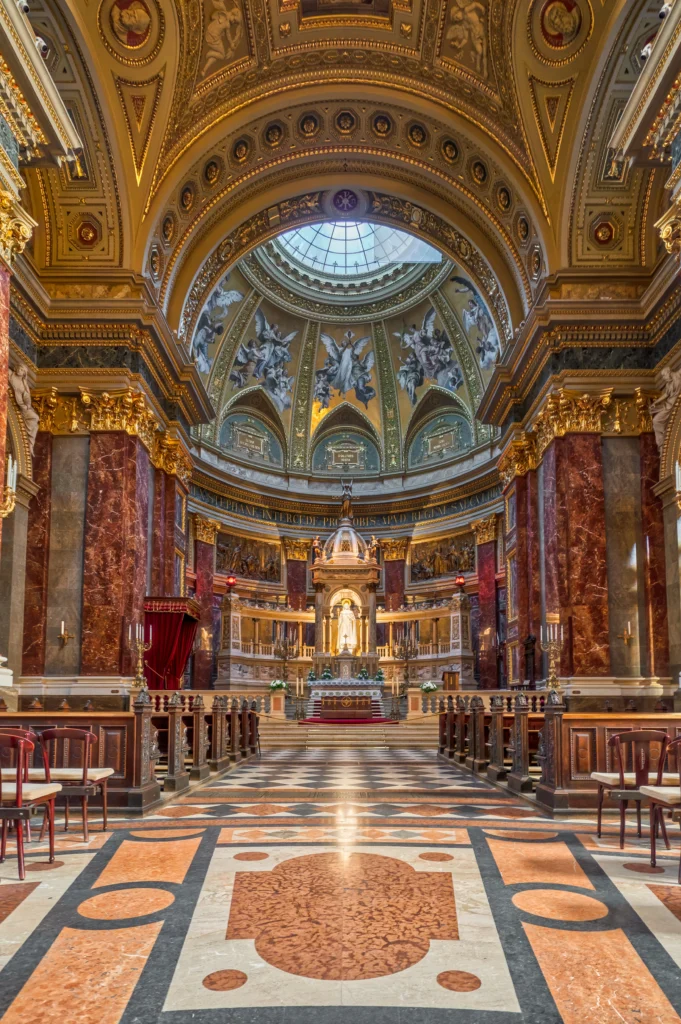
Photo by: DepositPhoto.com – All rights reserved. Do not reuse without permission.
Interior view of St. Stephen’s Basilica’s main altar area, showcasing the elaborate golden decorations, marble columns, religious frescoes on the dome, ornate chandeliers, and baroque architectural details.
The interior is adorned with marble sculptures and intricate artwork, showcasing the skills of Hungarian artists. The building’s bell towers contribute to its majestic presence, housing the largest bell in Hungary.
The basilica represents architectural grandeur, reflecting the artistic and engineering achievements of its time, solidifying its status as an iconic landmark in Budapest.
Despite the devastation of World War II, St. Stephen’s Church Budapest miraculously avoided major destruction. Its survival through this turbulent era allowed future generations to admire its original grandeur, making it one of the few historic landmarks in Budapest that retained its structural integrity.
Location and Accessibility in Budapest
Located in the heart of Pest, St. Stephen’s Basilica occupies a prominent position in Budapest’s urban landscape. Situated near other major attractions, such as the Hungarian Parliament building and Matthias Church, the basilica is easily accessible by public transportation, including the Budapest metro.
Visitors can also reach the basilica on foot while exploring the city centre. The basilica’s location on St. Stephen’s Square (Szent István tér) allows for easy access to guided tours, organ concerts, and other events held within its walls. For those seeking panoramic views of Budapest, climbing the 364 steps or taking the elevator to the terrace around the dome is a must.
Exploring the Largest Church in Hungary
Unique Features of St. Stephen’s Basilica
St. Stephen’s Basilica, while often referred to as the largest church in Hungary, is actually the third largest church in Hungary. St. Stephen’s Basilica is known for its unique features that distinguish it from other religious buildings in Budapest.
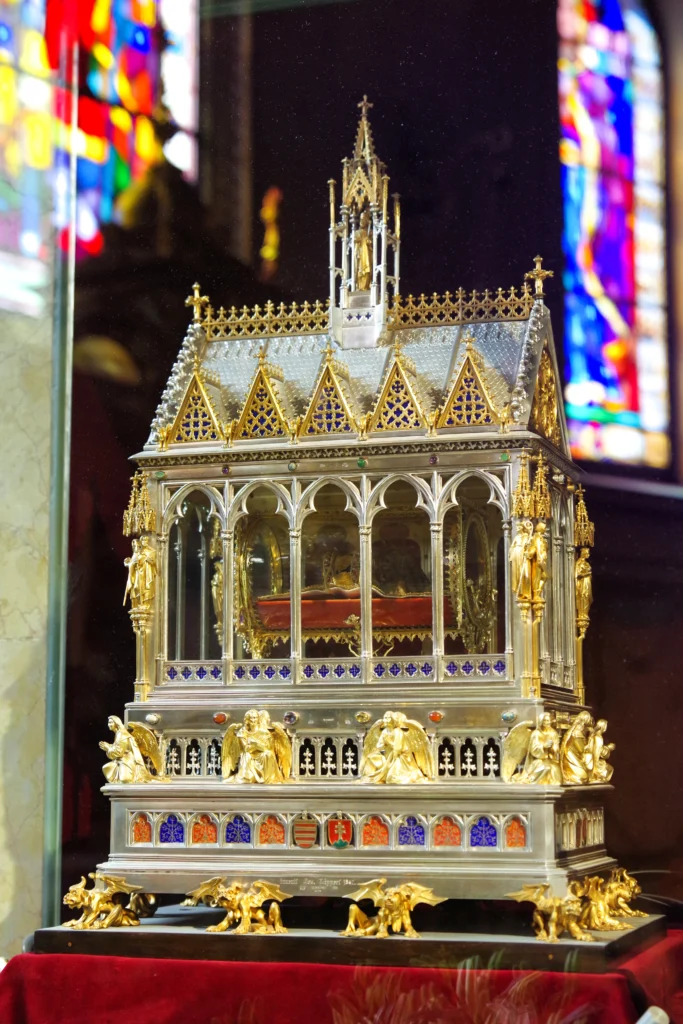
The mummified right hand of St. Stephen displayed in an ornate gold and silver reliquary at St. Stephen’s Basilica in Budapest.
One notable aspect is the relic of St. Stephen’s holy right hand (Szent Jobb), a treasure of immense religious significance to Hungarian Catholics and on display for visitors. The architecture, designed in neo-classical style, showcases the artistic talents of Miklós Ybl and other architects, resulting in a magnificent building that dominates the Budapest skyline.
Furthermore, the basilica’s impressive bell towers house the largest bell in Hungary, adding to its majestic presence. These elements combine to make the basilica a unique and unforgettable attraction.
Comparison with Matthias Church
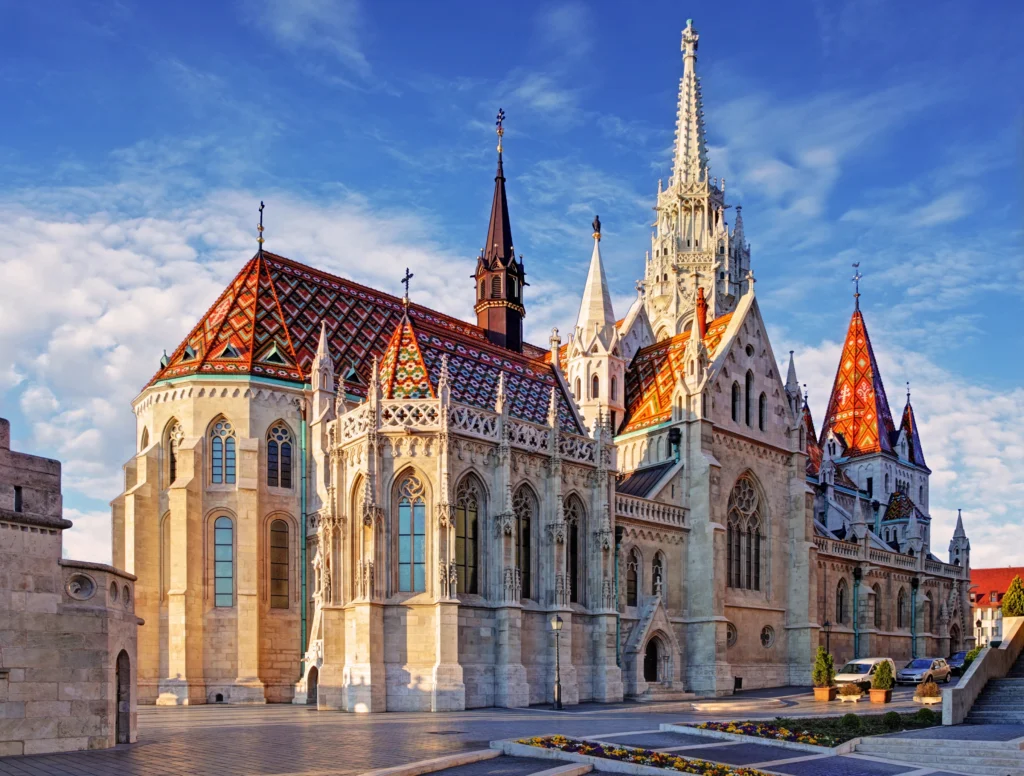
Matthias Church (Church of Our Lady) in Budapest’s Castle District, featuring its distinctive colorful geometric tile roof and Gothic Revival architecture, with the medieval Fisherman’s Bastion archway visible in the foreground.
While both St. Stephen’s Basilica and Matthias Church are significant religious sites in Budapest, they differ significantly in architecture and historical context. St. Stephen’s Basilica, with its neo-classical architecture, presents a more formal and grand appearance compared to Matthias Church. Matthias Church, also situated in the city centre, showcases a more eclectic style, reflecting centuries of architectural evolution.
While the Szent István Bazilika is dedicated to St. Stephen, the first king of Hungary, Matthias Church has been the site of numerous royal coronations and historical events, imbuing it with a different historical aura. Both serve as prominent cultural attractions, but their aesthetic and historical narratives provide distinct experiences. Comparing the basilica is one way to dive into history of Budapest.
Inside the Basilica: A Tour of the Main Attractions
Inside St. Stephen’s Basilica, visitors can embark on a captivating tour of the main attractions, which showcase Hungarian artistry and religious devotion. The interior is adorned with stunning marble sculptures and intricate mosaics, reflecting the skills of Hungarian artists.
One of the highlights is the dome, offering panoramic views of Budapest. The Chapel dedicated to St. Stephen provides a serene space for reflection, while the crypt houses the tombs of prominent religious figures.
Organ concerts frequently take place, filling the basilica with the sounds of classical music and showcasing the talents of renowned organists. Exploring the interior provides a glimpse into the basilica’s artistic and spiritual richness, making it a memorable experience.
Furthermore, taking guided tours ensures a comprehensive understanding of the basilica’s history and significance.
Tickets and Visiting Information
How to Purchase Tickets for St. Stephen’s Basilica
Purchasing tickets for St. Stephen’s Basilica (Szent István Bazilika) is generally straightforward, allowing visitors to easily access this important Catholic cathedral.
Entry to the basilica itself is often free, although donations are appreciated to support the building’s maintenance. However, accessing certain areas, such as the dome or treasury, typically requires a ticket purchase. These tickets can often be bought on-site at the ticket counter or in advance online, offering a convenient way to plan your visit and avoid potential queues.
Be sure to check the basilica’s official website for the most up-to-date information on ticket prices, availability, and any special events, such as organ concerts, that may require separate ticketing. Consider the type of experience you want, as some ticket options may include guided tours or access to exclusive areas. The basilica is one of the most important destinations in Budapest.
Guided Tours vs. Self-Guided Visits
When visiting St. Stephen’s Basilica, you have the option of exploring through guided tours or self-guided visits, each offering a unique experience.
Guided tours provide in-depth insights into the basilica’s history, architecture, and religious significance. Knowledgeable guides share stories about St. Stephen, the first king of Hungary, and point out key architectural features designed by Miklós Ybl, like the imposing dome.
Self-guided visits allow you to explore at your own pace, spending as much time as you like admiring the marble sculptures, stunning stained glass, and other artistic treasures.
Both options provide access to the main areas of the basilica, but a guided tour enriches the experience with valuable historical context. Consider your interests and preferences when deciding which approach best suits your visit to the Szent István Bazilika.
Accessibility and Visitor Guidelines
St. Stephen’s Basilica strives to be accessible to all visitors. The main entrance provides ramps for wheelchair access. The underground crypt may be accessible only via stairs. Inside the basilica, wide aisles allow for easier navigation.
When visiting, respectful attire is expected, as the basilica is an active place of worship. Photography may be allowed in certain areas. Be mindful of services or events. The magnificent dome and the relic of St. Stephen’s right hand add to the basilica’s charm. Experiencing this Budapest building is a memory that will last forever. The relic is considered a treasure by Hungarians of Catholic denomination.
Service animals are typically permitted. It’s advisable to check the basilica’s official website for updated information on accessibility features and any temporary restrictions.
Concerts and Events at St. Stephen’s Basilica
🎵 Unforgettable Organ Concerts in a Sacred Setting”
St. Stephen’s Basilica is renowned for its exceptional organ concerts, offering a profound musical experience within the majestic setting of this Hungarian building. The acoustics of the basilica enhance the richness and depth of the classical music, creating an unforgettable atmosphere for both performers and audiences.
These organ concerts frequently feature renowned organists performing classical music, showcasing the impressive capabilities of the basilica’s magnificent organ. The events draw music lovers from around the world, eager to experience the fusion of music and architecture. Attending an organ concert within the walls of the Szent István Bazilika is a cultural highlight. Ticket information and concert schedules are on the basilica’s site.
Special Events and Religious Ceremonies
Beyond the organ concerts, St. Stephen’s Basilica hosts a variety of special events and religious ceremonies throughout the year, reflecting its role as one of the most important Catholic cathedrals in Hungary. These events range from traditional masses and religious festivals to special celebrations honoring St. Stephen, the first king of Hungary.
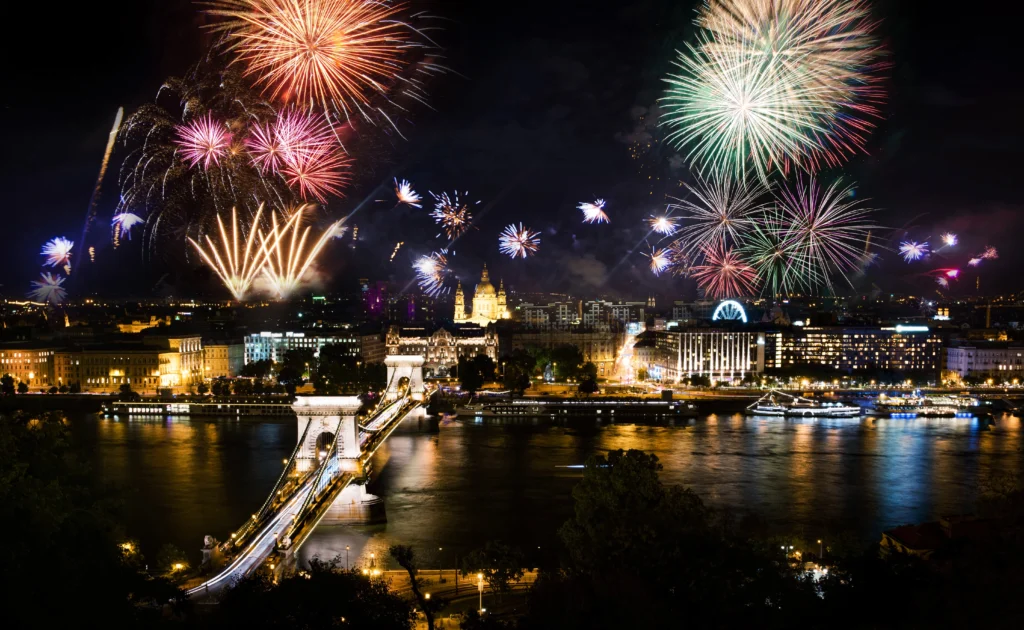
Colorful fireworks display over the illuminated Buda Castle complex in Budapest at night, with the grand baroque palace buildings lit in golden light reflected on the Danube River below.
During these occasions, the basilica comes alive with vibrant processions, choral performances, and religious rituals. The building itself serves as a backdrop, adding to the spiritual atmosphere. Attending one of these events provides a unique insight into Hungarian culture and the significance of religion in Hungarian society. Visitors can also explore the underground crypt during events.
Tip – Stephen’s Day, or Szent István Napja is celebrated of August 20.
Planning Your Visit Around Concert Dates
To make the most of your visit to St. Stephen’s Basilica, it’s advisable to plan around concert dates and special events. Organ concerts are a highlight. To see the relics, plan your trip for a special day of veneration. The basilica’s website provides a calendar of events, allowing you to schedule your visit accordingly.
Purchasing tickets in advance is recommended, especially for popular concerts. Arriving early ensures you have ample time to explore the basilica’s architecture, admire the stunning marble sculptures, and soak in the atmosphere before the concert begins. Planning allows one to fully appreciate the blend of culture, history, and spirituality offered at the Szent István Bazilika. Attending services and concerts adds to the basilica’s appeal.
Exploring the Surrounding Area
Nearby Attractions: What to See in the Centre
Located in the heart of Budapest, St. Stephen’s Basilica is surrounded by a wealth of attractions that showcase the city’s historical and cultural richness. A short walk away stands the Hungarian Parliament building, a stunning example of architecture and a symbol of Hungarian democracy. Matthias Church, another significant religious site, is worth visiting, offering a contrast in style and history.
The Danube River, with its picturesque bridges and waterfront views, is easily accessible from the basilica. Visitors can also explore the shopping streets, cafes, and restaurants that line the city centre, providing opportunities to experience the city’s atmosphere. The surrounding area complements the basilica’s presence.
Enjoying the Square and Terrace Views
St. Stephen’s Square (Szent István tér), which surrounds St. Stephen’s Basilica, offers a pleasant space to relax and admire the basilica’s grandeur. The square often hosts events, such as Christmas markets and food festivals, adding to its vibrancy.
Climbing to the terrace around the dome of the Szent István Bazilika provides panoramic views of Budapest, showcasing the city’s skyline and landmarks. The terrace offers a unique perspective of the cityscape. The architectural design, including the dome, built in neo-classical style, is admired from the top.
Spending time in the square and on the terrace allows visitors to fully appreciate the basilica’s prominent position in the city’s landscape. Enjoying the square provides different views of the building.
Dining and Shopping Options Nearby
The area surrounding St. Stephen’s Basilica offers a diverse range of dining and shopping options to suit various tastes and preferences. Numerous restaurants serve traditional Hungarian cuisine, allowing visitors to savour local flavors and specialties.
Cafes provide opportunities to relax and enjoy coffee. Shopping enthusiasts can explore the many shops selling souvenirs, local crafts, and Hungarian products. From high-end boutiques to charming local stores, the area offers a variety of shopping experiences.
Exploring the dining and shopping options around the Szent István Bazilika adds to the overall experience of visiting this iconic Budapest landmark. One can acquire treasures and local treats.
The mummified right hand of St. Stephen displayed in an ornate gold and silver reliquary at St. Stephen’s Basilica in Budapest.
Why You’ll Love St Stephen’s Church Budapest
- See the Holy Right Hand relic up close
- Climb to the dome terrace for city views
- Enjoy world-class organ concerts
- Discover rare artworks and mosaics
- Relax in the vibrant square with coffee and souvenirs
St. Stephen, also known as István I, was the first King of Hungary and is credited with founding the Hungarian state in the year 1000. He played a crucial role in converting Hungary to Christianity and was later canonized as a saint for his efforts in establishing a Christian kingdom.
St. Stephen is revered not only as Hungary’s first king but also as a saint who united various tribes under one Christian monarchy. His right hand, known as the Holy Right, is preserved as a relic and housed in St. Stephen’s Basilica, making him a national and religious symbol.
St. Stephen’s Basilica is one of the most important and impressive churches in Hungary. It is known for its stunning neoclassical architecture, panoramic dome views of Budapest, and housing the mummified Holy Right Hand of King Stephen. It is also one of the tallest buildings in the city.
Absolutely. The basilica offers a rich mix of history, art, and spirituality. Visitors often praise the breathtaking interior, the organ concerts, and the opportunity to climb (or take the elevator) to the dome for one of the best views in Budapest.
